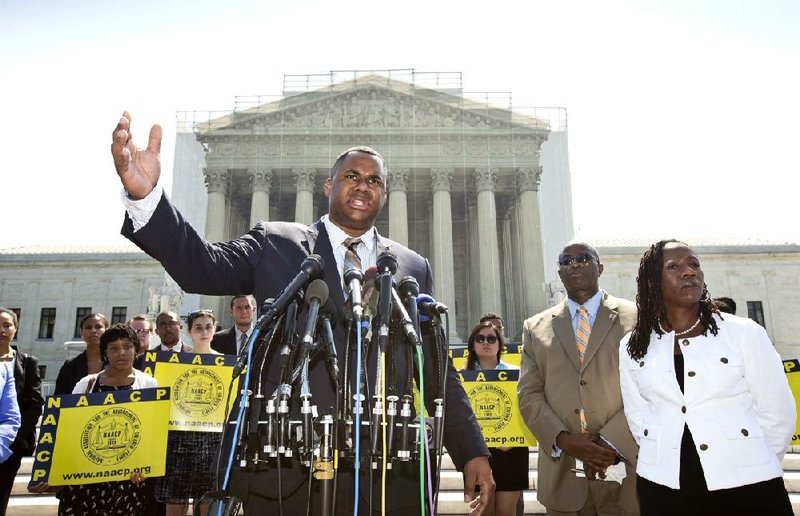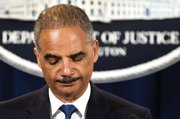WASHINGTON - A divided U.S. Supreme Court threw out a core part of the 1965 Voting Rights Act, rolling back a landmark law that opened the polls to millions of Southern blacks.
The justices, voting 5-4 Tuesday, struck down the law’s formula for determining which states must get federal approval before changing their election rules. The ruling all but invalidates that pre-clearance requirement, leaving it without force unless Congress can enact a new method for determining which jurisdictions are covered.
The ruling is one of the biggest civil-rights decisions in decades. The decision blocks a tool the Justice Department has used to halt thousands of state and local voting changes, including identification laws in Texas and South Carolina last year.
“Our country has changed, and while any racial discrimination in voting is too much, Congress must ensure that the legislation it passes to remedy that problem speaks to current conditions,” Chief Justice John Roberts wrote for the court.
Justices Antonin Scalia, Clarence Thomas, Anthony Kennedy and Samuel Alito joined Roberts in the majority.
Under the pre-clearance requirement, all or parts of 15 states had to get federal approval before changing election districts, amending voting rules or even moving a polling place. The Justice Department used that provision, which covers virtually the entire South, to object to more than 2,400 state and local voting changes from 1982 to 2006.
The court majority faulted Congress for relying on a decades-old formula for determining which states were covered by the pre-clearance requirement, also known as Section 5. The formula ties coverage to voter-registration rates, turnout and ballot-box rules in the 1960s and early1970s.
“Those extraordinary and unprecedented features were reauthorized - as if nothing had changed,” Roberts wrote. “In fact, the act’s unusual remedies have grown even stronger.”
The court left Section 5 itself intact. Thomas wrote that he would have invalidated that as well.
Congress reauthorized the law in 2006, extending it for 25 years on lopsided votes: 98-0 in the Senate and 390-33 in the House. Then-President George W. Bush, a Republican, signed the measure into law.
Justices Stephen Breyer, Ruth Bader Ginsburg, Sonia Sotomayor and Elena Kagan dissented.
“After exhaustive evidence-gathering and deliberative process, Congress reauthorized the Voting Rights Act, including the coverage provision, with overwhelming bipartisan support,” wrote Ginsburg, who read a summary of her dissent from the bench. “In my judgment, the court errs egregiously by overriding Congress’s decision.”
The Voting Rights Act was enacted to combat discrimination that kept black people away from Southern polling places for generations. A separate section of the law bars voting discrimination nationwide and isn’t affected by the high court case.
U.S. Sen. Charles Grassley of Iowa, the top Republican on the judiciary panel, said the court’s ruling reflects that the nation has changed.
“It proves that after 45 years that the Voting Rights Act is working,” Grassley said of the court’s ruling.
The law was challenged by Shelby County, Ala., which said Congress had failed to show that the law was still needed.
“We’re elated,” Frank C. Ellis Jr., Shelby County’s attorney, said from his office in Columbiana, Ala. “If you’re imposing on sovereign states and cities and counties this burden - this extraordinary burden and departure from federalism - you’ve got to have current justification, not justification that’s 50 years old.”
Edward Blum, who organized the Shelby County challenge, said the ruling “confirmed that there are no meaningful differences in minority voting opportunities between the covered and noncovered jurisdictions.” Blum is the director of the Project on Fair Representation in Alexandria, Va.
Republican U.S. Sen. Jeff Sessions of Alabama said almost 50 years after the Voting Rights Act was enacted, “you go to Alabama, you go to Tennessee, Georgia, North Carolina, people aren’t being denied the right to vote because of the color of their skin.”
“The world has changed since 1965,” he said.
Congressman Jeff Duncan, R-S.C., called the decision “a win for fairness, South Carolina, and the rule of law.” In a statement, he said: “The court’s ruling will hopefully end the practice of treating states differently and recognizes that we live in 2013, not the 1960s.”
Some Republicans were moving quickly to capitalize on the ruling in their states. In Texas, Attorney General Greg Abbott cheered the decision and said he would go ahead with implementation of a law, previously blocked by the provision invalidated Tuesday, that requires voters to show photo identification when registering to vote.
The Justice Department had said Texas failed to show that the law wouldn’t “have the effect of denying or abridging the right to vote on account of race,” and a federal court agreed.
Roberts said Congress “may draft another formula based on current conditions.” Still, political realities are likely to make that task difficult, if not impossible.
“As long as Republicans have a majority in the House and Democrats don’t have 60 votes in the Senate, there will be no pre-clearance,” U.S. Sen. Charles Schumer, a Democrat from New York, said in a statement.
President Barack Obama said in a statement released by the White House, “I am deeply disappointed with the Supreme Court’s decision today.” The ruling “upsets decades of well-established practices that help make sure voting is fair, especially in places where voting discrimination has been historically prevalent.”
Obama called on Congress to pass new legislation in response to the ruling. Senate Majority Leader Harry Reid, a Democrat from Nevada, said the Senate “will act.”
U.S. Sen. Patrick Leahy, the chairman of the Senate Judiciary Committee, said he will schedule a hearing next month.
“Many Americans who were protected by this law will now be vulnerable to discriminatory practices and will have much greater difficulty accessing the ballot box,” Leahy, a Democrat from Vermont, said in a statement.
Before Congress moves to revive the pre-clearance requirement, “it’s got to be justified and has to be one that applies equally around the country, or be justified as to why one area is targeted and another is not,” Sessions said.
The Obama administration contended that the reauthorization was a legitimate use of Congress’ power under the Constitution’s 14th and 15th Amendments to combat racial discrimination.
The administration said the formula originally was reverse-engineered to include the jurisdictions Congress wanted to cover. In 2006, lawmakers simply left the formula intact so that the same jurisdictions would continue to be covered, the administration argued.
The coverage formula was designed to include states with the deepest history of discrimination - Alabama, Georgia, Louisiana, Mississippi, South Carolina and Virginia. Three other states - Alaska, Arizona and Texas - were added in the 1970s when the statute was expanded to protect “language minority” groups.
Congress let some areas escape coverage if they can show compliance with anti-discrimination rules. Lawmakers also let judges put other areas under the pre-clearance system.
Section 5 eventually came to govern a patchwork of jurisdictions around the country. Parts of some covered states are exempt, while selected cities and counties in California, Florida, New York, North Carolina, South Dakota and Michigan were covered.
Supporters of Section 5 say the ruling may let state and local governments revive discriminatory voting practices that were previously either blocked or deterred.
“Today, the Supreme Court stuck a dagger in the heart of the Voting Rights Act of 1965,” said Georgia Democratic Rep. John Lewis, a civil-rights leader who was beaten by police and suffered a fractured skull during a 1965 march that spurred passage of the Voting Rights Act. “It took people struggling and dying for the right to vote.”
Sherrilyn Ifill, president of the National Association for the Advancement of Colored People’s Legal Defense and Educational Fund, said the ruling “takes the most powerful tool our nation has to defend minority voting rights out of commission.”
The Supreme Court upheld the pre-clearance requirement on four previous occasions as a legitimate means of enforcing the 15th Amendment, which bars states from restricting voting on the basis of race.
Although Arkansas was not one of the original states covered under Section 5, it has been required to submit changes to the federal government for clearance on a limited basis in what is known as a “bail-in” provision in the voting law.
In the majority opinion, the court cites Arkansas as a state where “the bail-in mechanism has … worked.”
In Jeffers v. Clinton, a group of black politicians challenged the state’s congressional districts, saying that they were drawn in such a way that made it difficult to elect black officials to the General Assembly.
In 1990, the U.S. District Court for the Eastern District of Arkansas ruled in favor of the plaintiffs. In his opinion, Judge Richard Arnold wrote that the state had violated the Constitution and discriminated against black residents.
“Some violations are distant in time, and their effects are in large part no longer with us,” he wrote. “Others have already been remedied by judicial action. Still others are not of the type curable by pre-clearance. But a limited pre-clearance remedy is still required by this record.”
Bill Clinton, then governor, appealed the case to the U.S. Supreme Court, but then withdrew the appeal.
The pre-clearance was used once after the case, when the federal government approved redrawn districts. Those redrawn districts were subsequently redrawn in 1992 after updated numbers were received from the U.S. Census.
Retired Arkansas Court of Appeals Judge Olly Neal of Marianna, who helped represent the plaintiffs in the Jeffers case before becoming a judge, said he was “extremely disappointed” with Tuesday’s Supreme Court decision.
Also on Tuesday, a Democratic legislator from Minnesota swiftly apologized for a Tweet he sent that referred to Thomas as “Uncle Thomas” after the majority ruling was announced.
Minnesota Rep. Ryan Winkler Tweeted: “#SCOTUS VRA majority is four accomplices to race discrimination and one Uncle Thomas. Marriage decision may blur Court’s backsliding.”
“Uncle Tom” is a connotation to describe someone subservient to another and has its roots in Harriet Beecher Stowe’s pre-Civil War novel about slavery, Uncle Tom’s Cabin. The latter part of the tweet refers to the high court’s expected decision on gay marriage.
Winkler, who is white, deleted the Tweet and told followers in his feed that he didn’t understand the phrase to be a racist term. He later told The Associated Press that he was trying to make a point about institutional racism resulting from the ruling. Information for this article was contributed by Greg Stohr, Julie Hirschfeld Davis, Laura Litvan, Roxana Tiron, Gigi Douban and Darrell Preston of Bloomberg News; by Alex Daniels of the Arkansas Democrat-Gazette; and by Brian Bakst of The Associated Press.
Front Section, Pages 1 on 06/26/2013


